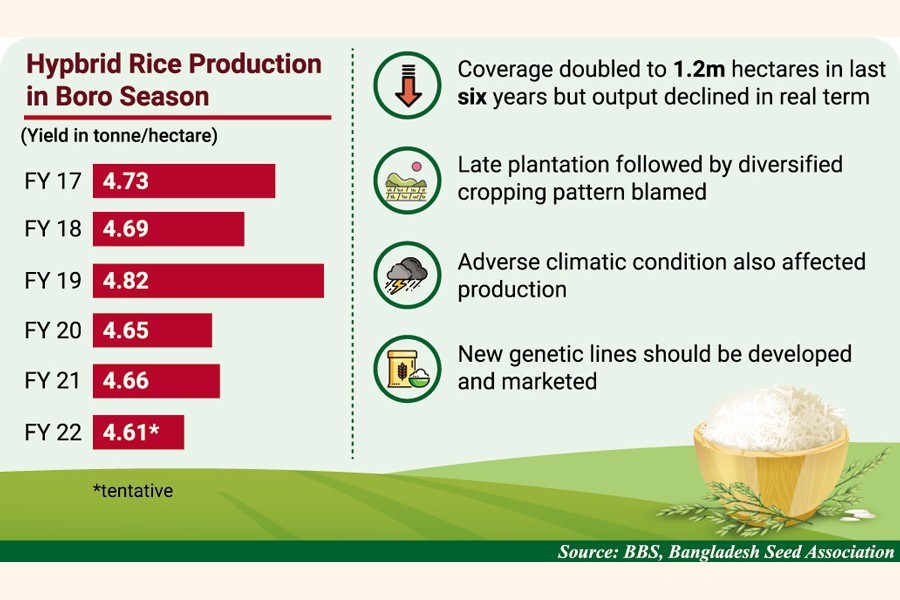
Published :
Updated :

Hybrid rice varieties have posted falling productivity in the last five years in Bangladesh, raising concern for policymakers as the government now largely depends on technology for future food security.
Although total Boro hybrid acreage increased to over 25 per cent, per-hectare yield (PHY) dropped to 4.65 tonnes in fiscal year (FY) 2021 from 4.82 in FY18, according to insiders.
The yield might have fallen further to 4.61 tonnes in FY22 as per primary estimates of the Bangladesh Bureau of Statistics, which is yet to publish output figures in Boro season that ended last June.
Lack of random varietal development both by public and private sectors, more vulnerability of hybrids to climate change, rough weather and late plantation are reasons behind this decline, said experts.
Habibur Rahman Chowdhury, director, Field Service Wing of Department of Agricultural Extension (DAE), said Boro hybrid rice fields rose to 1.21-million hectares or 24.8 per cent of the total acreage in FY21.
He said hybrid rice was cultivated on 0.66-million hectares of land or nearly 14 per cent of the total Boro acreage in FY17.
Mr Habib said food-grain procurement in large quantities and also the development of hybrids have contributed largely to such high-yield growth.
Twelve districts under Mymensingh, Sylhet, Rangpur and Khulna divisions are producing over 51 per cent of the total Boro hybrid rice output, he added.
The key hybrid seed entities are market leaders Supreme Seed Co Ltd, National Agricare Ltd, ACI, National Seed Co Ltd, Ispahani Marshal Ltd, Aftab Bahumukhi Farms Ltd, Buyer Crop Science and the government-run BADC.
SL-8 is a hybrid being marketed by the Bangladesh Agricultural Development Corporation (BADC).
It claims SL-8 gives 5.5-6.0 tonnes of rice per hectare.
Seed supply is very low as the BADC has hardly raised its production to 1,000 tonnes in the past six to seven years.
Dr Rezaul Karim, seed distribution head at BADC, said they have farm shortages for higher seed production.
Farms in Jashore and Jhenidah mostly use SL-8 seeds, he added.
Mustafizur Rahman, managing director of National Agricare Ltd, which markets Janakraj and National-branded hybrid rice, claimed Janakraj gives 40-42 maunds of paddy per 33 decimal or one bigha of land.
This means a minimum of 7.0 tonnes of rice per hectare.
Mr Mustafiz said his company processes 1,000-1,200 tonnes of seed locally and imports another 300-400 tonnes.
Asked, he expected higher production as the private sector would focus on super-hybrid and other modern techs to raise output.
ACI Seed director Sudhir Chandra Nath said an optimal result from hybrids could not be achieved for diversified cropping pattern of Bangladesh.
He said PHY in mono-cropping areas like Habiganj, Sunamganj, Barisal, Gopalganj and other low-lying regions is gradually increasing as farmers maintain proper time to plant seedlings in December.
But the peasantry in Rangpur, Dinajpur, Naogaon, Rajshahi and other rice hubs are forced to delay plantation to January and February, Mr Sudhir added.
"Late plantation deprives us from desired yield of 5.0-5.5 tonnes," he continued.
Mr Sudhir said his company has now 13 hybrid varieties of which ACI Hybrid-06 (known as Chhokka) in Boro and Arize Dhanigold in Aman are more popular.
Chhokka's PHY is 5.0-5.5 tonnes while Dhanigold shows a tremendous 4.5-5.0 tonnes in Aman season, he claimed.
Supreme Seed chairman Mohammad Masum said local companies and entities supplied more than 12,000 tonnes of locally developed hybrid rice seed while imported only 2,000 tonnes last year.
Mr Masum said his company earlier marketed 2,800 tonnes of its Hira-branded seed.
According to market leaders, the total turnover from the hybrid seed trade in Bangladesh is more than Tk 3.5 billion annually.
"Rice area for the variety has doubly increased in Boro season in the last half decade, almost 25 per cent of the total acreage but it happened without ensuring high productivity," said Bangladesh Institute of Development Studies professorial fellow Md Asaduzzaman.
"This declining trend would be disastrous in coming years as climate impacts and changing ecology have started to become more random in recent decades."
Mr Asad said the government has targeted to maximise hybrid rice acreage for food security as Boro hybrid rice production reached 5.5 out of 20-million tonnes.
Any negative growth of production in hybrid fields is thus a great concern for the government, he added.
"Research should be prioritised to get optimal from the technology introduced in the country two-and-a-half decades back," Mr Asad suggested.
He further suggested that stress-tolerant as well as high productive hybrids and inbreeds be introduced on a regular basis as per farmers' demand.
Dr Wais Kabir, former executive chairman of the Bangladesh Agricultural Research Council, said the state-run Bangladesh Rice Research Institute has so far developed seven hybrid varieties.
Four of the varieties are much suitable for Boro season, he added.
He said the BADC is now not enough to supply such seed alone in a diversified market.
"The DAE should be involved actively in seed development to popularise suitable varieties like BRRI Hybrids and SL-8," Mr Kabir said.
He also put high emphasis on a public-private collaborative research effort to get desired rice varieties in a changing climatic condition.


 For all latest news, follow The Financial Express Google News channel.
For all latest news, follow The Financial Express Google News channel.